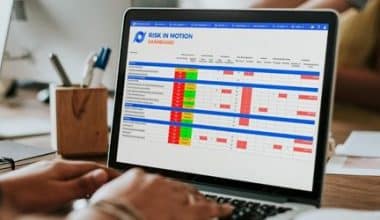Portfolio management involves scenarios where an investor’s financial goals and risk tolerance are taken into consideration when developing and managing a portfolio. This guide covers both the portfolio management salary and the projects they handle.
Portfolio Management
Weighing strong points and limitations, opportunities and dangers, across all investments is essential to portfolio management. Portfolio management can be active or passive. Just know that both are valid approaches.
Passive management is a long-term approach to a philosophy that says “set it and act as if you’ve never done it.” One or more exchange-traded (ETF) index funds may be used in this strategy. Index investing is a frequent term for this type of investment. One can use modern portfolio theory (MPT) to aid those who design indexed portfolios to improve the balance. Moreover, the goal of active management is to outperform an index through the purchase and sale of selected securities as well as other investments.
Types of Portfolio Management
Roles differ irrespective of the same goal, which is making money. Here are the types of portfolio management and their roles.
#1. Active Portfolio Management
Active portfolio management’s goal is to outperform the market’s expectations. Those that invest in this manner are frequently considered to be irrational. As soon as a stock’s value rises above the average, it is sold by active managers. Statistical analysis of firms is a key component of active portfolio management, which entails comparing the share price to the possible return. Rather than relying on the efficient market theory to substantiate his assertion, the active manager uses ratios.
The active manager’s preferred method of reducing investment risk is to spread investments across multiple industries. Active portfolio management has the drawback of relying solely on the manager’s abilities. If you can find an expert in value investing, you can expect to make a lot of money.
#2. Passive Portfolio Management
Passive investing is the reverse of active management. The effective sector proposition is a belief that those that adhere to it hold strongly. The notion is that the stock price always reflects an industry’s fundamentals. Consequently, index funds with low turnover but high long-term value are what passive managers prefer.
Choosing a lower yield is a way to save money on management expenses while still reaping the benefits of stability.
#3. Discretionary Portfolio Management
The investor’s discretionary manager has complete freedom to act on his or her behalf. Even though the manager considers the individual’s objectives and timeframes, he uses whatever method works best for him. Investment returns begin to pour in after making a cash payment to a financial professional.
#4. Non-portfolio management
As a financial advisor, the non-discretionary manager serves no other purpose. It is his job to advise investors on the best course of action. It is up to the investor to weigh the benefits and drawbacks of each option. The manager can only act on behalf of the investor once investor approval has been provided.
Read Also: Sales Process: Steps & Stages to Close Sales Efficiently in 2023!!!
Is There Anything That Affects the Salary of Portfolio Management?
Numerous things can affect the salary of portfolio management. The typical annual compensation for a portfolio manager in 2019 was $81,590, according to the Bureau of Labor Statistics. As an example, those in the top 10% of earnings earned more than $156,150, while those in the bottom 10% earned less than $47,230.
Here are a few possible reasons why portfolio management salary is so different from one another.
#1. Company’s industry and its employer
Depending on your boss and the industry you work in, you can earn a lot of money as a portfolio manager. It’s possible that some companies or industries pay more or are in more demand for portfolio managers than others.
#2. Experience
Your investment skills and experience will likely improve as you put them to the test and gain experience. Because of this, experienced portfolio managers and financial analysts are likely to earn more money than those who are just beginning their careers. As this is the case, it could help to explain the widening wage disparity between the highest and poorest 10% of earnings.
#3. Location
Depending on where a portfolio manager is located, he or she may earn a larger salary than someone else in the same position. Portfolio managers in New York, for instance, may earn more than their counterparts in other places. As the need for portfolio management varies geographically, so can your salary.
General Portfolio Management Salary
A portfolio manager’s (management) yearly salary in May 2019 was $94,160 on average, according to the BLS.
Here are the top-paying states, locations, and industries for portfolio management to help you better comprehend how much you may earn as a portfolio manager. These include: $132,290 for New York, Washington, D.C. $106,490, $100,250 in Connecticut, New England is $102,610 and $101,600 for the state of Alaska.
Portfolio Management Projects
Portfolio management projects are processes that project management organizations utilize in order to assess possible financial gain. Proposal and current project data are organized and consolidated by project portfolio managers, who then provide firm forecasts and business analyses for new initiatives.
Set of tools for portfolio management projects.
Portfolio management projects solutions come in many varieties, but these are the most effective:
- Allow for the enterprise-wide portfolio management of projects.
- Interfaces and functionalities that are easy to use should be provided.
- Improve online collaboration and communication aspects.
- They provide comprehensive reporting and data analysis.
Enterprise portfolio management projects software that’s simple to use.
The enterprise portfolio system enables you to use a single resource with a wide range of capabilities throughout your organization. Reduced reliance on various programs, which can add overhead and confound workflows, can be achieved by using enterprise portfolio solutions. Portfolio management projects are inherently complex due to the sheer volume of information that must be kept track of. Thus, it’s critical that the tool used be user-friendly for everyone, not just the early adopters.
Look for products that reduce the amount of time spent on administration, manual labor, and documentation requirements. Instead, choose a tool with an intuitive interface, straightforward performance, and a smartphone app that everyone in your organization can use from any location.
The central communication hub
It’s not uncommon for companies and organizations to employ remote workers to work on many projects at the same time. It can be challenging to maintain clear lines of communication when members of your team are in different places.
Internet connectivity to the most effective portfolio management software removes any communication boundaries. With one central point of contact, you can be sure that all team members are on the same page and offer real-time status reports. Secondly, archive and exchange information such as documents and feedback. Thirdly, it takes less time to answer queries or solve difficulties. Finally, utilize data in a timely and efficient manner and make it available to stakeholders.
Read Also: CHANNEL MANAGEMENT: Meaning, Examples & Why It Is Important
Standard operating procedures for portfolio management
Portfolio management’s best procedures will obviously differ from one company to another, just like in the real world. Any project, like every portfolio, will have specific requirements. In spite of this, most industries can benefit from tried-and-true strategies.
#1. Conduct a thorough project inventory.
Managing your portfolio effectively necessitates an inventory of all your initiatives. Include the name of the project, the start and end dates, the estimated budget, the company’s goals, the expected return on investment, and any other relevant information. Meanwhile, it’s possible to generate an instant high-level overview with all the information needed to give shareholders with updates or make more effective decisions on the spot.
#2. Consider projects from a strategic perspective.
Individual projects are put into priority according to how well they align with the company’s long-term strategic goals. A project’s risk level and whether or not it necessitates significant reengineering are two more considerations to keep in mind.
In the end, a skilled portfolio manager would identify early overlapping project ideas and cut off any initiatives with poor business justifications up front, to guarantee better synchronization between management and stakeholders.
#3. Organize, classify, and allocate resources to projects.
In addition to prioritizing based on available cash and resources, you must also evaluate each project in terms of strategic alignment. Reaching your financial objectives necessitates meticulous planning because cash flow is a limited resource. The number of initiatives your budget and available resources can support will naturally dictate where you draw the line, but using a scoring system can make this process much simpler.
#4. Ensure you manage your investments well.
If your portfolio isn’t actively handled after you’ve created the authorized project list, no amount of excellent review and prioritizing will assist.
Portfolio Management Pros and Cons
When it comes to determining whether or not to manage projects in the form of a portfolio, there are numerous factors to consider. Quickly compare the benefits and drawbacks of project portfolio management by using the following
Pro
- Avoiding problems before they occur minimizes hazards before they arise.
- Standardized processes reduce the amount of time spent on repetitive operations, which in turn reduces the amount of time needed to complete a project.
- Utilizing data from existing and previous projects will accurately estimate costs.
- The Portfolio view allows you to understand what resources are available and what resources are necessary for new projects, allowing you to optimize your resources.
- Standardized processes increase the likelihood of project success because they allow for improved forecasting of project output over time.
- It’s easier to work together on projects when everyone can see the decisions that are being made.
Cons
- It’s important to factor in the cost of recruiting, coaching, software, and developing new processes.
- Portfolio Project Management necessitates the allocation of resources that many small enterprises lack.
- Having to Make Tough Decisions: Setting priorities necessitates making many difficult choices about numerous essential initiatives.
- A lack of feedback from managers on the ground, who have a deep understanding of the day-to-day activity, might be a problem when prioritization methods are standard.
- Time is a precious commodity. Procedure development and execution consume time that could be used or spent in other ways.
- When adopting new Portfolio Project Management, obtaining executive support for processes that have not been demonstrated can be a challenge.
What Is the Role of Portfolio Management?
Decisions on investments are made by portfolio managers. They create and manage portfolios, decide what and when to acquire and sell investments, and develop and implement investment strategies and processes to suit client goals and restrictions.
Why Is It Important To Have a Portfolio?
An ever-evolving collection of documents called a portfolio serves as a record of your qualifications, abilities, experiences, and personality traits. It emphasizes and displays examples of some of your best work, as well as your accomplishments, values, and life experiences.
What Is the Most Important Part of a Portfolio?
Unquestionably, the most crucial component overall is the images in your portfolio. Prospective clients are unlikely to want to place their trust in you for their building project if the images of your prior projects don’t appear professional because they can’t even see the quality of your work correctly.
What Is a Portfolio Typically Used For?
Students may be encouraged to take more control and ownership of their education through the use of portfolios. Portfolios are a tool for students in certain institutions to assess their own work and academic growth, frequently as they are choosing what will be included in their portfolios.
What Characteristics Distinguish a Successful Portfolio?
Potential clients and companies are interested in learning more about the concepts and processes behind your finest designs. Therefore, a strong portfolio will frequently also include drawings that help add clarity to the work in addition to showing photographs of final designs.
What Is the Most Effective Portfolio?
A portfolio that delivers the largest expected return for a given level of risk, or one that has the lowest level of risk for a given expected return, is said to be efficient. The efficient frontier is the line that connects each of these efficient portfolios.
What Number of Things Ought To Be in a Portfolio?
To have a well-diversified portfolio, investors should have at least 60 stocks in their holdings. Consider a low-cost, broad-market index fund instead if you want to start investing but don’t have the time to conduct your homework.
Conclusion
Portfolio management is when an investor’s financial goals and risk tolerance must be taken into consideration when developing and managing a portfolio
PORTFOLIO MANAGEMENT FAQs
What are the five 5 requirements of portfolio management?
- Evaluate the Current Condition.
- Setting Investment Objectives
- Decide how to allocate assets.
- Decide on your investment strategy.
- Measure and re-align your body’s needs.
What is the importance of portfolio?
There are a number of ways in which you can use portfolios to exhibit the skills you would include on your CV or converse about in a question and answer session.
What is the first step of portfolio management?
A policy statement is the first step in the portfolio management process. The investor’s risk tolerance is outlined in their policy statement. Understanding and articulating investment objectives and constraints is the primary goal of this exercise.






